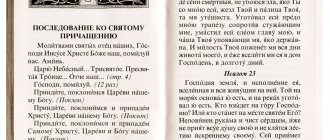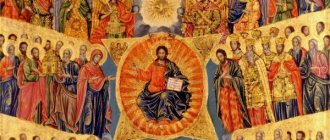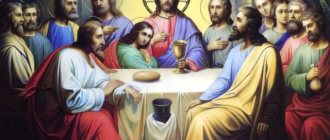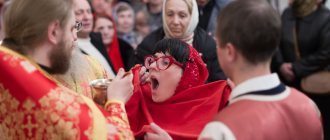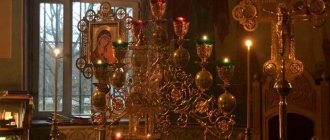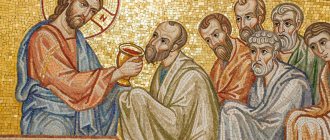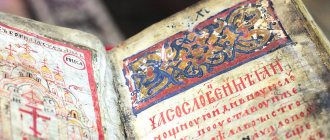APOSTOLIC RULES
More scientists con. XIX - early XX century believed that it was impossible to find accurate data about the time of the appearance of A. p. (Nikodim [Milash], Bishop Pravo. P. 89), just as it is impossible to admit that they received their beginning directly from the apostles (Suvorov. Pravo. P. 145). However, Trul also denies the direct authorship of the apostles. Cathedral. In Ap. 85 speaks of the “Apostolic decrees”, and “the decrees spoken through Clement in eight books” are placed by the compiler on a par with the books of the Holy. Scripture, “from which it is clear that the author of the rules is interested in ensuring the authority of a truly apostolic work behind the decrees - this interest indicates that both the rules and decrees belong to the same person” (Suvorov. Law. P. 146 ). A number of textual coincidences also give reason to believe that the Apostolic Constitutions were compiled after the Apostolic Constitutions and that the latter served as a source for them (Chapter 47 of Book VIII of the Apostolic Constitutions contains the “Rules of the Holy Apostles”; see modern research M. Mesge on the Apostolic Constitutions - Metzger. T. 3: Introd. § 500-505; see also: Pavlov. Law. P. 48-49). In addition, other chapters of the “Apostolic Constitutions” contain texts that exactly correspond to A. p., for example: “And I, Simon the Canaanite, decree how many a bishop should be ordained. A bishop is ordained by three or two bishops. If anyone is ordained as one bishop, then let both he and the one who ordained him be deposed” (Apostolic Constitution VIII 27) and “Let two or three bishops appoint bishops” (Apostle 1). “There is no doubt that a significant part of Ap. rules contains norms that have been preserved in church practice since the times of the apostles. But it cannot be denied that some of them belong to much later times. Such, for example, is the 30th canon, which prohibits seeking the episcopacy with the help of secular authorities, or the 37th canon, which prescribes that church councils should meet in each province twice a year - it is clear that both canons could only have happened in those times , when the Church had already entered into an alliance with the Roman state, that is, under the first Christian emperors, or, what is the same, not earlier than half of the 4th century” (Pavlov. Law. P. 49).
Bearing in mind the manuscripts of the “Apostolic Constitutions”, which include 85 rules (Vat. gr. 839, 10th century; Vat. Barber. gr. 336, last quarter of the 8th century; Vat. gr. 1506, 1024 .; RNL. Greek 100, 1111), prof. Mesge believes that the rules reveal correspondence, and sometimes even letters. coincidence with the rules of the Universe. I (325), Antiochus. (c. 330; for the dating of the Council that adopted the rules, see the article “Councils of Antioch”) Councils, a collection of rules attributed to Laodice. Council (between 343 and 381), rules of Ankyr. (314) and Neokesar. (c. 319) Councils and were ordered only before the Ecumenical. II Council (381). It is not known whether the compiler had a specific collection of earlier rules, or whether he knew them in separate series (Metzger. T. 1. P. 22-23). In church-historical, canonical and pathological literature (Pavlov. P. 49; Suvorov. P. 146-147; Leclercq. Col. 1916-1917; Metzger. T. 1. P. 22-23) attention is focused on the close the similarity of certain APs and the rules of Antiochus. Council (Ap. 32 and Antioch. 6, Ap. 33 and Antioch. 7, Ap. 34 and Antioch. 9, Ap. 36 and Antioch. 18, Ap. 37 and Antioch. 20, Ap. 38 and 40 and Antioch. 24, Ap. 41 and Antiochus 25). Most researchers are inclined to believe that the compiler of the AP had before him the decrees of Antiochus. Cathedral, and not vice versa. However, it should be noted that the text of A. p., including the early texts, is laconic, the rules of Antiochus. The Council, on the contrary, is more detailed and thorough, which usually indicates a later origin. In addition, A. p. come from a different and more ancient church structure than the rules of Antiochus. Cathedral. For example, if the content of Ap. is similar. 34 and Antiochus. Ap. 9 speaks of the delimitation of church regions according to ethnic principles, of course related to territorial ones: “It is fitting for the bishops of every nation to be the first nobility in them”; 9th right Antiochus. The Council proceeds from the existence of metropolitan districts corresponding to the adm. division of the Roman Empire into provinces, introduced in the beginning. IV century under Diocletian. Therefore the first bishop is in Antiochus. 9 is called Metropolitan.
Text Sat. "Rules of the Holy Apostles" sire. origin. The first clear reference to the authority of A. p. is found in the resolution of the Polish Council of 394, the chairman of which was Archbishop. Nektarios, originally from the Cilician city of Tarsus, which was part of the Antioch (Syrian) church region.
Recognition of apostolic authority behind the “Rules” is not equivalent to the assimilation by the apostles of the text of the rules itself. In the 16th century, after the publication of the Magdeburg Centuries, in which doubt was expressed about the apostolic origin of the Rules, F. Turrian tried to prove that they were written down by the apostles at the Jerusalem Council of the Apostles. Careful study of their contents and text, finally realizing that if the ancient Church had recognized these “Rules” as apostolic writings, they would have been included in the New Testament canon, has led scholars to the general opinion that the “Rules” were not written or dictated by the apostles . But the apostolic authority of the “Rules” is evidenced by their complete agreement with the teachings of the New Testament. Some rules coincide with the text of Scripture (which perhaps speaks in favor of their early origin). In the Epistles of the Holy Apostles (1 Tim 3.2-13; 2 Tim 1.5-9; 1 Peter 5.1-3; 3 John 1-10) the qualities that a person entering the clergy must possess, as well as the responsibilities clergy; the same requirements are contained in Ap. 17, 25, 42, 43, 44, 61, 80. The apostolic authority of the “Rules” is also evidenced by their compliance with the norms of church life of the first centuries. In I Universe. 15 contains a demand to stop the custom “contrary to the apostolic canon... so that neither bishop, nor presbyter, nor deacon passes from city to city.” And in Ap. 14 it says: “It is not permissible for a bishop to leave his diocese and move to another”; in Ap. 15: “If anyone is a presbyter, or a deacon, or in general on the list of clergy, leaving his limit, goes to another... we command him not to serve any more.”
About the rules of the holy Apostles
In all canonical collections of the Orthodox Church, the 85 rules of St. are in first place. Apostles).
The importance and significance of these rules in the universal church for all times was confirmed by the Council of Trullo (691) with its 2nd rule, declaring, “so that from now on... those accepted and confirmed by the saints and blessed fathers who lived before us, as well as those dedicated to us in the name of of the holy and glorious Apostles, eighty-five rules" ).
Having proclaimed and confirmed the importance of these Apostolic rules, the fathers of the Trullo Council at the same time explain the origin of these rules, namely: they explain that these rules are directly St. The apostles did not set them down in writing (έκτεθέντας), as is said in the same 2nd rule regarding the remaining rules, but that they originated from the apostolic tradition, were preserved through oral tradition by the successors of the apostles, who accepted the mentioned rules and passed them on to others, and finally they were dedicated to them (the fathers of the Council of Trullo) with the name of the Holy Apostles (ονόματι τών 'Αποστόλων).
If St. The apostles themselves did not set out these rules in writing, but these rules were preserved in the church from the apostolic tradition, that is, what they orally conveyed to the heads of the churches they founded, then the question arises: when does that apostolic tradition first become known in the church? which is expressed in the Apostolic Canons in their present form? Who collected this apostolic tradition and compiled these rules from it? And finally, was there at the very beginning the same number of these rules as the Trullian Council mentions and how many are currently accepted by the Orthodox Church?
1. That these rules deserve in the full sense the authoritative name of the Holy Apostles and the respect that the universal Church recognizes for them, and that they serve as an accurate expression of what the Apostles set forth in writing in their writings and handed down to their first successors orally - serve as proof complete agreement of these rules in their basic thoughts with the teaching contained in the canonical books of the New Testament Holy Scripture; further proof is that they strictly correspond to the church practice presented to us in the writings of the apostolic men and their closest successors, and finally, apostolic authority was recognized for them by the councils and fathers of the first centuries of the church).
The first time the rules of the Holy Apostles were clearly mentioned was at the first ecumenical council, therefore at the beginning of the 4th century. In its 1st canon, speaking about those who were castrated by force, the council adds that such, “however, they will be found worthy, the rule admits into the clergy,” and this is precisely what is discussed in the 21st Apostolic Canon. In its 2nd rule, the same council says that it is contrary to the “church rule” to accept into the clergy “people from pagan life who have recently come to the faith”; and the 80th Apostolic Canon speaks about this. Likewise, in their other canons, the fathers of this council expressly refer to the Apostolic canons.
At the same time, that is, in the first half of the 4th century, the Apostolic Canons and other councils, fathers and teachers of the church clearly refer to them. The Council of Antioch (341) in many of its rules either literally repeats the Apostolic rules, or develops in great detail the thoughts that are contained in individual rules; Moreover, the order in the Antiochian canons is essentially the same as in the Apostolic canons). The Council of Constantinople, regarding the feud over the former bishopric, in the same 4th century, decided that a bishop could only be judged by a “greater council of bishops,” as defined by the Apostolic Canons; and this is precisely what defines the 74th Apostolic Canon.
In the biography of King Constantine, belonging to Eusebius of Caesarea, we read a letter from the king to Eusebius, where the king praises Eusebius for not wanting to accept the see of Antioch and leave his own, for by doing so he fulfilled the prescription of the Apostolic Rule, which prohibits the movement of a bishop from one place to another ); and this is precisely what the 14th Apostolic Canon prohibits. Athanasius the Great, in order to prove the illegality of his overthrow by the Arians, refers to Apostolic Canon 74 as a positive church law that determines which people can accuse a bishop). Basil the Great in many of his rules refers to the ancient rules (by which he means the Apostolic Rules), issuing his various canonical instructions).
After the 4th century, all councils and church fathers mention the Apostolic Canons as generally known throughout the church. And in the 6th century these rules appeared in the form of a special collection with the name of St. Apostles.
Based on everything that has been said so far, especially on the basis of rules 1 and 2 of the First Ecumenical Council, which point to the Apostolic rules, such as those that were known to all the fathers of the council, following. bishops of the entire Christian world, it can be confidently stated that the Apostolic Canons in their present form and number became generally known throughout the church at the end of the 3rd century or, at the latest, at the beginning of the 4th century).
2. John of Damascus in his essay “On the Orthodox Faith” says that the Apostolic Rules were collected by Clement, meaning, of course, Clement of Rome, the successor of the Apostles, who lived in the 1st century of the Christian era, who was mentioned as a collector of these rules back in the 6th Century) . With all the reverence for Damascene for his many written works, it is impossible, however, to accept what he says about the person who collected the Apostolic canons in one collection, for it has now been proven by science that, except for one epistle to the Corinthians, Clement of Rome did not belongs to nothing else of all that was previously considered to belong to him).
At the same time, Clement, who is mentioned in Apostolic Canon 85 as the publisher of the collection of Apostolic Rules, or more precisely, “Apostolic Constitutions (Διαταγαι τών 'Αποστόλων),” and on the basis of which Damascene, without a doubt, expressed his mentioned view, this Clement distinguishes himself from the writer Epistle to the Corinthians, namely Clement of Rome, since in the said Apostolic Canon he speaks of himself in the first person, and mentions the writer of the epistle in the third person).
So, it was not Clement of Rome who collected and published the Apostolic Rules, and not Clement of Alexandria († 217), as the famous publisher of the rules of the Eastern Church, Beveridge (Beveregius), never proved, for there is no irrefutable evidence in favor of this opinion). Neither Papias of Hierapolis nor Egesippus, both from the 2nd century of the Christian era, about whom Eusebius of Caesarea in his history says that they collected the apostolic tradition and wrote down everything that they heard from different persons who had communication with the Apostles, could not have been the collector of these Apostolic rules ). The opinion that the collector of these Apostolic Rules could have been either Papias or Hegesippus arose from the general expressions of Eusebius, that the two mentioned persons collected and wrote down everything that they heard from the Apostolic tradition; but nowhere is this stated definitely, not only in Eusebius, but not in any other writer of the most ancient era, and therefore nothing definite can be based on this.
Professor of the Roman Catholic University in Tübingen, Dr. Dray, in the first half of the last century, wrote an extensive study about the Apostolic Rules, a study many in the West consider authoritative and have essentially accepted his conclusions and conclusions about the time and the collector of these rules). In the newest Freiburg Roman Catholic Dictionary, the contributing writers still adhere to Dray's conclusions). According to Drey, the Apostolic Rules were collected twice, namely: the first time in the 5th century 50 rules were collected, the second time at the beginning of the 6th century 35 rules of the latter, and thus from these two collections one collection of 85 rules was compiled in the East , while the West retained only a collection with 50 rules, and rejected another collection with 35 rules as apocryphal.
Drey does not dwell much on the question of the collector, since he cannot, on the basis of his own research, recognize either one or two collectors, but several, and since - according to his argumentation - the aforesaid rules do not represent, with small exceptions, anything other than repetition of the rules of various councils: Nicene, neo-Caesarean, Antioch, Laodicean, even Chalcedon. This opinion of Drey about the origin of the Apostolic Rules might have been accepted, but for this the professor had to prove that the reverse work was impossible, i.e., that the aforementioned councils did not borrow their canonical decrees from the collection of the Apostolic Rules, like such We made the conclusion here on the basis of recognized canonical authorities. And since Drey did not prove this, his opinion cannot be given serious significance.
Mortreil, a lawyer from Marseille, also from the first half of the last century, speaking about the collection of the Apostolic Rules, expressed the idea that this collection was compiled around the middle of the 3rd century, when all the various disciplinary decrees were collected, which were preserved in individual churches by oral tradition). And this opinion of Mortreil is closest to the truth.
Without, therefore, decisive evidence in favor of one specific compiler of the collection of the Apostolic Rules, we can, based on the above, say that these rules were compiled and collected in one collection at the end of the 3rd century or, at the latest, at the beginning of the 4th century by an unknown pious person , who called these rules “Apostolic,” wanting to show their true origin.
3. We have seen that in the second canon of the Council of Trullo the 85 Apostolic Canons are mentioned. We find such a number of Apostolic Rules in the canonical collection of John Scholasticus, Patriarch of Constantinople, who compiled his collection around 550, next, 140 years before the Council of Trullo). Before this time, it is unknown who mentions the collection of the Apostolic Rules with so many rules. But that they were in such numbers from the very beginning is evidenced by the practice of the church of the first centuries, as can be seen from the writings of the fathers and teachers of the church of this era. The Eastern Church has always accepted and recognized this number of Apostolic Rules, and still accepts and recognizes them.
In the West, only 50 Apostolic Rules have been adopted. In the first half of the 6th century, the abbot of a Roman monastery, Dionysius exiguus, at the invitation of Bishop Stephen of Solin (in Dalmatia), translated one canonical collection from Greek into Latin, and placed 50 Apostolic Canons at the beginning of the collection). Based on this Dionysian collection, the entire West, with greater or lesser restrictions, adopted exactly the same number of these rules.
There are two opinions why Dionysius accepted only 50 Apostolic Rules into his collection.
According to some, this depended on the characteristics of the Greek collection from which Dionysius made his translation and in which there were only 50 rules - they prove their view by the difference in the text of the rules, as they are set out in the Dionysian collection, from the text of the same rules in Greek handwritten collections) . But it is difficult to accept this opinion, for it is almost impossible to admit that Dionysius, having received an invitation to translate the rules of the Eastern Church for the ecclesiastical use of the West, so easily understood his work and would not have tried to compare at least several Greek manuscripts and, based on them, compile his own collection , whose task was so important. And this comparison should, without a doubt, lead him to the conclusion that in the East a much larger number of rules were recognized and accepted; Moreover, at that time Stephen of Ephesus published his canonical Synopsis, in which, if we do not find 85 Apostolic canons, but only 77, but in their (synoptic) content they correspond to all our current 85 canons.
We must also say about the Synopsis of Simeon the Master from the Dionysian era, where 82 rules are given). And a few years after Dionysius, John Scholastic published his canonical collection, which contained a full 85 rules. In accordance with this, the above opinion that Dionysius contributed not 85, but only 50 rules to the collection must be recognized as unfounded and very superficial because the Greek manuscript from which he made his translation contained only 50 rules.
Others claim that Dionysius translated only 50 rules, and omitted the last 35 and included in his collection the translation of only the first 50 rules, for this was entrusted to him from Rome). Judging by how the West generally looked at all the Apostolic canons with some suspicion and how Dionysius himself had to deal with these canons in different editions of his canonical collections, this opinion can be considered insufficiently substantiated. It was by no means pleasant for Rome to spread in the West, with the authority of the apostolic name, such rules that on many issues contradicted the practice of the Western Church and, moreover, condemned this practice. It is enough to pay attention to individual issues that are discussed in various rules from 51 onwards, and confirmation of what has been said will immediately be obvious. For example, the question of the celibacy of the clergy was a lively concern for the Western Church in the first centuries, and they tried in every possible way to force every clergyman to be unmarried. Many councils of the 3rd and 4th centuries in Gaul and Spain anathematize married clerics; The decretals of the popes threaten the cleric who lives with his wife with the strictest punishments; Pope Siricius calls the married life of a priest a crime.
Given this state of affairs, it is not surprising that the West should have immediately rejected the rule that bore the name of the Apostolic and which, meanwhile, decisively overthrew the theories of celibacy. This is one of the rules not accepted by the West, or according to our calculation, the 51st Apostolic Canon. Fasting on Saturday became a custom in the West and was legalized by the decrees of individual Western councils and papal decretals; to accept and recognize the authority of the 66th Apostolic Canon, which prohibits such fasting, would mean before the whole world to admit one’s departure from the apostolic tradition. Fasting on Wednesday was forgotten in the West; they did not want to restore it, despite all the efforts of even Western church teachers themselves (especially Blessed Augustine); and 69 The Apostolic Canon directly prescribes this fast and thereby condemns the Western Church for its innovation. Apostolic Canon 70 condemns anyone who eats unleavened bread in church, and in the West, even then, the custom of performing St. liturgy on unleavened bread.
Such a solution, contrary to Western customs, to these and similar issues, which in the West were of vital importance as a means to achieving special goals, naturally should have caused the kind of opposition against the Apostolic Rules that we see in the 6th and subsequent centuries. And after this, it seems to us, it is now clear that the collection of the Apostolic Rules should contain the number of rules that the Eastern Orthodox Church first accepted and still recognizes, and that the Western Church, for the above reasons, rejected the last 35 rules, accepting only the first 50 at the beginning of the 6th century rules
Likewise, the meaning of the Apostolic Rules (not to mention their number) was not the same both in the West and in the East, although in the first edition of the Dionysian Collection the title of the rules stated that they were prolata per Clementem ecclesiae Romanae pontificem. While the East recognized their apostolic origin, the same Dionysius calls them Canones qui dicuntur Apostolorum, but adds that many doubt their apostolic origin; and in another canonical collection, which he later prepared, but from which the preface has been preserved, he completely omitted the Apostolic Canons, justifying himself by saying, quod non admisit universitas, ego quoque iu hoc opere praetermisi). The Roman bishops could not have wished for the decrees contained in canons 5, 17, 18, 26 and 40 regarding the marriage of holy persons, in canon 6 - on what priests should do, in canon 34 - on the recognition of the independent power of the metropolitan, in canon 35 and 37 rules - on limiting the sole power of the Roman bishop in the church, or in rule 50 - on baptism through immersion. Therefore, the Roman bishops, using the power they had in the West, had to prohibit the dissemination of the Apostolic Rules and declare them apocryphal. Pope Gelasius issued (494) a decree de libris non recipiendis, and in addition to that decree, by the decision of one Roman bishop (apparently Hormizda † 523), the collection of Apostolic Rules was included among the prohibited books).
In general, the Apostolic Rules almost lost all their significance in the West over the next three centuries. Only in the 9th century did False Isidore again accept these rules into his collection according to the Dionysian translation). Afterwards, they were included in the Gratian Decree (XII century), due to the recognition of the 2nd rule of the Trullo Council as binding for the Western Church, in the amount mentioned in this rule, following. all 85 rules, although the same decree contains extracts only from the first 50 rules according to the Dionysian translation). Currently, the definitions of the Apostolic Rules are as important in the West as the Decretum Gratiani, which, however, constitutes the first section of the Roman Catholic Corpus juris canonici.
Thus we have shown that the Apostolic Rules come from St. Apostles, that in their present number they were verbally handed over from the Apostles to their first successors, and these apostolic successors preserved them by tradition until the last years of the 3rd century, or the first years of the 4th century, and that at that time they were gathered together by an unknown pious person one collection, accepted and recognized by the universal church, in the words of the 2nd canon of the Council of Trullo, “for the healing of souls and the healing of passions.”
All the Apostolic Rules are found in the current official collections of individual local churches: the Slavic Helmsman, the Russian Book of Rules, the Greek Pidalion and the Romanian Indreptarea legii. Only in the latter they are summarized into 83 rules.
With the name of St. There are several more rules of the Apostles in our Helmsman, which make up chapters 2, 3 and 4 in it, namely 17 rules of the Apostle Paul (chap. 2), 17 rules of Peter and Paul (chap. 3) and 2 rules of “all saints of the Apostle together” ”(4 chapters). These rules were extracted from Book VIII of the so-called Apostolic Constitutions and included in the Synopsis on which Aristinus wrote his interpretations and which served as the basis for both our Helmsman and the Indreptarea legii, although these rules are not in this last collection). These rules are optional, for the Council of Trullo, with its 2nd rule, deprived the very source from which they were taken of all legal force. Zonara says the following about them: “Since the 2nd rule of the sixth council defines exactly this and does not mention anywhere about any other Apostolic rules except these 85, then no other rules should be accepted that bear the Apostolic name, on the contrary, such should be condemned, considered false and rejected, because they bear false titles, are damaged and are not listed among those approved by the holy and divine fathers."
Last edited by Nikolay; 03/17/2007 at 07:32.
45. A bishop, or presbyter, or deacon, who prayed only with heretics, shall be excommunicated. If he allows them to act in any way, like the servants of the Church: let him be deposed.Zonara. This is stated in the previously written rules. Also look for the 64th rule and the 70th.
Aristen. The one who prays is excommunicated with the heretics; and whoever recognizes them as clerics is ejected. A presbyter or deacon who has only prayed with heretics is excommunicated; and if he allowed them to do anything, he is ejected as persons, initiates and clergy.
Valsamon. Perhaps someone will ask: why are bishops, presbyters and deacons who prayed with heretics not expelled, but only excommunicated, like one who prayed with any of the excommunicated, according to the 10th Apostolic Canon? Solution. You can say that here it is not clear that the bishop and other clergy in the temple prayed together with heretics, for such, according to the 46th rule, should be subject to eruption, as well as the one who allowed them to do anything as clerics. But take the expression “to pray together” instead of “to have ordinary communication” and “to be more lenient towards the prayer of a heretic,” for such, as worthy of disgust, should be abhorred, and not have communication with them. Therefore, the punishment of excommunication seemed sufficient.
Slavic helmsman. Pray for the heretics to excommunicate. If I accept it as a clergyman, it will erupt.
Interpretation. A bishop, or a presbyter, or a deacon, if he prays only with a heretic, or in the house, or in the church, let him leave. If he commands them to serve in the church, like a presbyter, or to serve as a priest, like a clerk, he will be ejected.
46. We command that bishops or presbyters who have accepted baptism or the sacrifice of heretics be cast out. What agreement does Christ have with Belial, or what part does the faithful have with the unbeliever?
Zonara. The Orthodox should move away from heretics and their ministries, and bishops and elders should more reprove and admonish them, lest they realize their errors and convert. If any bishop or presbyter accepts someone baptized by heretics, or takes from them any offering that is being sacrificed; then he should be cast out, because it gives the suspicion that he is either wise like them, or has not been in a hurry to correct their evil thoughts. For he who deigns to serve them, how could he reproach them, and advise the heretics to abandon them?
Aristen. A priest who accepts baptism and the sacrifice of heretics is deprived of his priesthood. That bishop or presbyter who does not blaspheme the baptism performed by heretics, but recognizes it or accepts offerings for sacrifice from them, is ejected, because there can be no agreement between Christ and the Belial, and no part between the faithful and the infidel.
Valsamon. This rule determines that those bishops and priests who accept the baptisms and sacrifices of heretics should be subject to eruption. And the great council of Constantinople quite legally punished by eruption some of the sacred persons who saw only the writings of the heretic Irinikos, but did not mock them or spit on them.
Slavic helmsman. If a bishop or presbyter does not blaspheme heretical baptism and take whatever from them as a sacrifice, let it be cast out. Baptism and sacrifice are heretical, the saint is not sacred.
Interpretation. A bishop, or a presbyter, or a deacon, if he does not blaspheme or swear at heretical baptism, but accepts the baptized from these, or sacrificed from them; that is, if he accepts service, he will be defrocked. Some combination of Christ and the Devil; or what part does the faithful have with the infidels? (1 Cor. 182).
Book of rules. This Apostolic Canon applies to heretics, such as there were in Apostolic times, who damage the main dogmas about God the Father and the Son and the Holy Spirit, and about the incarnation of the Son of God. Regarding other types of heretics, further decrees are presented by the following rules: First Ecumenical Council rule 19th, Laodicean 7th, 8th, Sixth Ecumenical Council 95th, Basil the Great 47th.
Prayer with heretics is prohibited, wake up!
Joint prayer with heretics
Joint prayer with heretics is prohibited by the canons of the Church, regardless of whether it is public or private. The Church’s prohibition of prayerful communication with heretics stems from love both for its faithful children, for the sake of protecting them from lies before God and wickedness, and from love for the heretics themselves: by refusing to pray with them, Christians testify that those who are mistaken are in danger, since they - outside the Church and therefore outside salvation.
45th Rule of the Holy Apostles
: “A bishop, or presbyter, or deacon, who prayed with heretics only, may he be excommunicated.
If he allows them to act in any way, like the servants of the Church, he will be deposed.” 10th Rule of the Holy Apostles
: “If anyone prays with someone who has been excommunicated from church communion, even if it were in the house, let him be excommunicated.”
Rule 65 of the Holy Apostles
: “If anyone from the clergy or layman enters a Jewish or heretical synagogue to pray, let him be deposed from the sacred rank and excommunicated from church communion.”
Canon 33 of the Council of Laodicea
: “It is not proper to pray with a heretic or renegade.” (Ap. 10, 11, 45, 46, 64; I ecum. 19; II ecum. 7; III ecum. 2, 4; Trul. 11, 95; Laod. 6, 7, 8, 10, 14, 31, 32, 34, 37; Basil Vel. 1, 47; Timothy Alex. 9).
He who has sex with a harlot becomes one body with the harlot. The one who prays with the heretic becomes one body with the heretical synagogue, regardless of whether he prays in a meeting of heretics or “privately” at home before dinner. Communication with heretics in prayer is spiritual adultery, union in lies and ontological betrayal of Christ.
That is why the canons speak of the inadmissibility of not only “official” or liturgical prayer, but also any prayer in general with a heretic, including private prayer.
The tenth apostolic canon reads: “If anyone prays with someone who has been excommunicated from church communion, even if it was in the house, he will be excommunicated.” The famous canonist of the 12th century, Patriarch of Antioch Theodore Balsamon, in his interpretation of this rule, says: “So whoever prayed with an excommunicated person, wherever and whenever he was, must be excommunicated.
This is written for those who say that the excommunicated is cast out of the church and that, therefore, if anyone sings with him in the house or in the field, he will not be guilty. For it makes no difference whether one prays in church together with the excommunicated person or outside it .
Also, the authoritative canonist of the 20th century, Bishop Nikodim (Milosz), writes: “Jesus Christ Himself laid the foundation for excommunication from His church, saying: “If he does not listen to the Church, then let him be to you as a pagan and a publican”
(
Matthew 18:17
), that is, in other words, let him be excommunicated from the Church.
Subsequently, the Apostles explained this in detail in their epistles, and also applied it in practice ( 1 Cor. 5:5; 1 Tim. 1:20; 2 Tim. 3:5; Titus 3:10; 2 Sol. 3:6; 2 John 10 and 11
). Thus, the rule strictly expresses the thought of St. Scripture, forbidding praying with someone who has been excommunicated from church communion, not only in church, when there is prayer common to all the faithful, but even at home alone with someone who has been excommunicated from the Church.”
The Orthodox Church prohibits not only joint prayers with schismatics and heretics, but also intentionally entering for prayer into a meeting of Gentiles (heretical synagogue - 65 rule of the Holy Apostles
), accepting heterodox “blessings” (
32nd canon of the Council of Laodicea
), allowing gentiles to act as ministers of the church (
45th canon of the Holy Apostles
), offering oil and lighting candles in gentile meetings (
71st canon of the Holy Apostles
).
Commenting on the 45th Apostolic Canon
, Bishop Nikodim (Milosz) says: “The 10th Apostolic Canon, as we have seen, forbids praying even at home with someone who has been excommunicated from church communion and imposes excommunication on everyone who has prayerful communication with the excommunicated person.
Naturally, all heretics must also belong to those excommunicated from church communion, which is why it is consistent to prohibit every Orthodox Christian from communicating in prayer with them. All the more strictly should such communication be prohibited to clergy, who are obliged to serve as an example for the rest of the faithful in preserving the purity of belief, not desecrated by any false teaching. By prayerful communication, or as the rule says, (“who will only pray”), according to Balsamon in the interpretation of this rule, one must understand not only the prohibition for the bishop and other clergy to pray in church together with heretics, since for this they are already liable eruption according to the 46th Apostolic Canon
, as well as for allowing heretics to do anything as clergy; but the words must be understood in the sense of “having simply communication” ( ) and “a heretic condescendingly looking at the prayer” ( ), for such, as worthy of disgust, must be avoided. Therefore, understanding the meaning of these words in this way, the Apostolic Canon considers one excommunication to be sufficient punishment. The matter takes a completely different turn when an Orthodox clergyman allows some well-known heretic to serve in the church, and generally recognizes him as a real clergyman or clergyman. In this case, this clergyman becomes unworthy of sacred service and, according to the prescription of this rule, must be deposed from the priesthood. The same thing is prescribed both by the Apostolic Decrees (VI, 16.18), and by many other rules, and such was the teaching of the entire Church of the first centuries. Archimandrite very wisely notes. John in his interpretation of this rule, saying that the rules strive not only to protect the Orthodox from the infection of the heretical spirit, but also to protect them from indifference to the faith and to the Orthodox Church, which can easily arise from close communication with heretics in matters of faith. This attitude, however, does not contradict the spirit of Christian love and tolerance that distinguishes the Orthodox Church, since it makes a big difference to tolerate those who are lost in the faith, expecting their voluntary conversion, or even insisting on it, to live with them in external civil communion, or enter into religious contact with them indiscriminately, since the latter means that we not only do not try to convert them to Orthodoxy, but we ourselves hesitate in it. This should be of particular importance for clergy, who are obliged to serve as an example for others in the strict protection of the shrine of the Orthodox faith. Because of this, an Orthodox priest, according to the rules, should not teach St. Tain, nor even perform any sacred service for them until they express a firm decision to unite with the church; still less can he allow a heretical priest to perform any service for the Orthodox.”
The ascetics of the 20th century not only strictly adhered to the Orthodox Faith in relation to heresy and heretics, but also called for refusal to participate in supra-church organizations like the World Council of Churches. Archbishop Seraphim (Sobolev) once wrote: “By being present at the heretical meeting, which ecumenists call the “All-Church Conference”, “the meeting of all Christian churches” and the “one holy Church of Christ,” Orthodox representatives thereby actually affirm the existence of this “one holy church.” Christ” with all its heretical errors. Consequently, without words, without any writing, Orthodox ecumenist representatives, by their very presence at the ecumenical conference, will contribute to the overthrow of our faith in the dogma of the Church.” And the Serbian theologian Reverend Justin (Popovich), urging not to participate in the “World Council of Churches,” wrote to his Holy Synod: “The position of the Orthodox Church regarding heretics - i.e. everyone who is not Orthodox - was established once and for all by the Holy Apostles and Holy Fathers, that is, by God-inspired Tradition, one and unchangeable. According to this provision, Orthodox Christians are prohibited from participating in any common prayer or liturgical communion with heretics. For what fellowship has righteousness with iniquity? What does light have in common with darkness? What agreement is there between Christ and Belial? Or what is the complicity of the faithful with the infidel? ( 2 Cor. 6, 14-15
).
(...) Without uniting with heretics, wherever their center is, in Geneva or Rome, our Holy Orthodox Church, always faithful to the Holy Apostles and Fathers, will not thereby renounce its Christian mission and evangelical duty, that is, it will be before the modern Orthodox and non-Orthodox worlds humbly but boldly testify to the Truth of the All-Truth, the living and true God-man and the all-saving and all-transforming power of Orthodoxy. The Church, led by Christ, through its patristic spirit and theologians, will always be ready to give an account of our hope to everyone who demands an account ( 1 Pet. 3:15
).
And our hope, forever and ever, is one and only: the God-man Jesus Christ and His Human-Divine Body, the Church of the Holy Apostles and Fathers. Orthodox Theologians should participate not in “ecumenical common prayer,” but in theological conversations in and about the Truth, just as the Holy and God-bearing Fathers have done throughout the centuries. The truth of Orthodoxy and true faith are a “part” only of those who are “saved” ( Canon 7 of the Second Ecumenical Council
).
The answer to the question about the admissibility of joint prayers with people of other faiths ultimately coincides with the answer to the question: do we believe in the One, Holy Catholic and Apostolic Church? Yes? No? Or do we believe, but not really? This “we believe, but not very much,” unfortunately, is the most common phenomenon and, at the same time, an indicator of average statistical indifference to the Faith. To the Faith, for which its holy witnesses - martyrs and confessors - gave up their flesh to be torn to pieces and parted with earthly life. The significant difference between the ancient theologians and many who call themselves theologians today is not that they dealt with other, seemingly more terrible and terrible heretics (heretics are always the same), but in the fact that they professed the theology of the Church while marching not with reports to the tribunes, and after Christ to Golgotha. But witnessing the Orthodox Faith from the stands of international conferences does not necessarily imply the overthrow of this Faith by participating in the joint prayers of people of other faiths.
Deacon Georgy Maximov
“Praying together with heretics is indeed a violation of the canons (45th Apostolic Canon, 33rd Canon of the Laodicean Council, etc. Let us turn to the text of the canon: “It is not proper to pray with a heretic or renegade” (33rd canon of the Laodicean Council). ... After the Laodicean Council of 364, several dozen Councils, both Ecumenical and Local, have already passed, but not one of them, until the most recent ones, considered it necessary to change this norm of the Ecumenical Church. On the contrary, it was confirmed at the IV Ecumenical Council of 451. , then at the Trullo Council of 691, finally, the 33rd rule was confirmed by the “District Epistle to all Orthodox Christians” of 1848 ... conciliarly adopted in 1848 “District Epistle of the One Holy Catholic and Apostolic Church to all Orthodox Christians” reads: “The newly introduced opinion that the Holy Spirit comes from the Father and the Son is a real heresy, and its followers, no matter who they are, are heretics; the societies made up of them are heretical societies, and all spiritual and liturgical communication with them of Orthodox children The Catholic Church is lawless.” And here is what the Monk Justin (Popovich) wrote in the 20th century, commenting on the proposal of non-Orthodox to Orthodox to pray together: “According to the 45th apostolic canon, “a bishop, or presbyter, or deacon, who prayed only with heretics, shall be excommunicated. If he allows them to act in any way, like the servants of the Church, he will be deposed.” This sacred rule of the holy Apostles does not indicate what kind of prayer or service is prohibited, but, on the contrary, prohibits any joint prayer with heretics, even private. These specified canons of the holy Apostles and Fathers are valid even now, and not only in ancient times: they remain unconditionally binding for all of us, modern Orthodox Christians. They are certainly valid for our position in relation to Roman Catholics and Protestants." It is difficult to come up with clearer expressions. So we have…clear definitions of the apostles, councils and holy fathers. There is another common erroneous argument: “When the canonical rule speaks of the inadmissibility of prayer with heretics, we are talking about prayer of a liturgical nature, and not about prayer at the “everyday” level. “Can’t you, having invited a non-Orthodox Christian into your house, read the Lord’s Prayer with him before eating?”
The Church answers this question with the 10th rule of the Holy Apostles:
“If anyone prays with someone who has been excommunicated from church communion, even if it were in the house, let him be excommunicated.”
As the canonist Aristin explains, “he who prays with heretics in church or in a house will be as deprived of fellowship as they are.” 65th Apostolic Canon:
“If anyone from the clergy, or a layman, enters a Jewish or heretical synagogue to pray, let him be deposed from the sacred rite and excommunicated from church communion
. As for logic, in my opinion, these decrees have meaning, logic, and the greatest benefit for the Church and care for us. Why did the apostles and holy fathers forbid praying with heretics, as well as in the churches of heretics? Perhaps because for them prayer and faith (theology) were not thought of as two areas independent of each other? For them it is an inextricable whole. Let us recall the remarkable expression of St. Macarius the Great: “He who is a theologian prays, and he who prays is a theologian,” as well as the famous early Christian saying: “The law of prayer is the law of faith.” And, naturally, unity in prayer can only be there and only with those with whom there is unity of faith. And if we pray with a heretic, then, firstly, we lie in the face of God, and secondly, we lie to the heretic with whom we pray. We mislead him by giving him reason to think that there are no significant differences between his faith and the faith of Orthodox Christians and that from the point of view of Christians his teaching is also saving. And this is not difficult to observe if we have the right guideline before our eyes and remember that “the Church’s prohibition of prayerful communication with heretics stems from love for the heretics themselves, who through such a religious (and not social) “quarantine” are called to realize their error and understanding the fact that they are outside the "ark of salvation."
